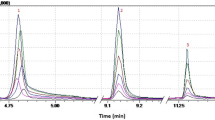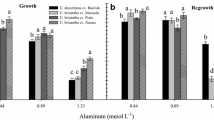Abstract
In the Cerrado vegetation, generally known as ‘Brazilian savanna’, aluminum (Al) accumulating and non-accumulating plants coexist, growing on soils that are acidic, poor in nutrients and rich in Al. Differing from Al-sensitive species, these plants are not expected to experience Al injuries. Using Styrax camporum, a non-accumulating plant, we recorded biometric variations in leaves, shoots and roots of young plants exposed to 0 and 1480 μM Al in a nutrient solution. Photosynthetic responses were measured bi-weekly over 91 days. Plants exposed to Al drastically reduced flushing, indicating that Al interferes with the functioning of the shoot apex. Aluminum caused low CO2 assimilation rate, largely explained by low stomatal conductance, while Al-induced decrease in photochemical performance occurred only on some dates during the experiment. In addition, the absorbed Al was mostly retained in the roots. Although counter-intuitive, as this species grows on Al-rich soils, we noted that high Al availability impairs lateral root formation, causing an impact on water uptake and gas exchange rates of this species.








Similar content being viewed by others
References
Andrade LRM, Barros LMG, Echevarria GF, do Amaral LIV, Cotta MG, Rossatto DR, Haridasan M, Franco AC (2011) Al-hyperaccumulator Vochysiaceae from the Brazilian Cerrado store Al in their chloroplasts without apparent damage. Environ Exp Bot 70:37–42
Baker NR (2008) Chlorophyll fluorescence: a probe of photosynthesis in vivo. Annu Rev Plant Biol 59:89–113
Blamey FPC, Edwards DG, Asher CJ (1987) Nutritional disorders of sunflower. The University of Queensland, Brisbane
Bolhàr-Nordenkampf HR, Öquist GO (1993) Chlorophyll fluorescence as a tool in photosynthesis research. In: Hall DO, Scurlock JMO, Bolhàr-Nordenkampf HR, Leegood RC, Long SP (eds) Photosynthesis and production in a changing environment: a field and laboratory manual. Chapman & Hall, London, pp 193–206
Brunner I, Sperisen C (2013) Aluminum exclusion and aluminum tolerance in woody plants. Front Plant Sci 4:1–12
Chaves MM (1991) Effects of water deficits on carbon assimilation. J Exp Bot 42:1–16
Chaves MM, Pereira JS, Maroco J, Rodrigues ML, Ricardo CPP, Osório ML, Carvalho I, Faria T, Pinheiro C (2002) How plants cope with water stress in the field. Photosynthesis and growth. Ann Bot 89:907–916
Chen L-S, Qi Y-P, Smith BR, Liu X-H (2005) Aluminum-induced decrease in CO2 assimilation in citrus seedlings is unaccompanied by decreased activities of key enzymes involved in CO2 assimilation. Tree Physiol 25:317–324
Clark RB (1975) Characterization of phosphatase of intact maize roots. J Agric Food Chem 23:458–460
Delhaize E, Ryan PR (1995) Aluminum toxicity and tolerance in plants. Plant Physiol 107:315–321
Demming-Adams B (1996) Using chlorophyll fluorescence to assess the fraction of absorbed light allocated to thermal dissipation of excess excitation. Physiol Plant 98:253–264
Feistler AM, Habermann G (2012) Assessing the role of vertical leaves within the photosynthetic function of Styrax camporum under drought conditions. Photosynth 50:613–622
Furlani AMC, Furlani PR (1988) Composição e pH de soluções nutritivas para estudos fisiológicos e seleção de plantas em condições adversas. IAC, Campinas (Boletim Técnico, 121). [In Portuguese]
Habermann G, Bressan ACG (2011) Root, shoot and leaf traits of the congeneric Styrax species may explain their distribution patterns in the Cerrado sensu lato areas in Brazil. Funct Plant Biol 38:209–218
Habermann G, Machado EC, Rodrigues JD, Medina CL (2003) Gas exchange rates at different vapor pressure deficits and water relations of ‘Pera’ sweet orange plants with citrus variegated chlorosis (CVC). Sci Hortic 98:233–245
Habermann G, Ellsworth PFV, Cazoto JL, Feistler AM, Silva L, Donatti DA, Machado SR (2011) Leaf paraheliotropism in Styrax camporum confers increased light use efficiency and advantageous photosynthetic responses rather than photoprotection. Environ and Exp Bot 71:10–17
Haridasan M (1982) Aluminium accumulation by some cerrado native species of central Brazil. Plant Soil 65:265–273
Haridasan M (2008) Nutritional adaptations of native plants of the cerrado biome in acid soils. Braz J Plant Physiol 20:183–195
Haridasan M, Araujo GM (1988) Aluminium-accumulating species in two forest communities in the cerrado region of central Brazil. For Ecol Manage 24:15–26
Horst WJ, Wang Y, Eticha D (2010) The role of the root apoplast in aluminium-induced inhibition of root elongation and in aluminium resistance of plants: a review. Ann Bot 106:187–197
Jiang H-X, Chen L-S, Zheng J-G, Han S, Tang N, Smith BR (2008) Aluminum-induced effects on photosystem II photochemistry in Citrus leaves assessed by the chlorophyll a fluorescence transient. Tree Physiol 28:1863–1871
Jiang H-X, Tang N, Zheng J-G, Li Y, Chen L-S (2009) Phosphorous alleviates aluminum-induced inhibition of growth and photosynthesis in Citrus grandis seedlings. Physiol Plant 137:298–311
Kissmann C, Habermann G (2013) Seed germination performances of Styrax species help understand their distribution in Cerrado areas in Brazil. Bragantia 72:199–207
Kissmann C, Tozzi HH, Martins S, Habermann G (2012) Germination performance of congeneric Styrax species from the Cerrado sensu lato areas and their distribution pattern in different physiognomies. Flora 207:673–681
Konrad MLF, Silva JAB, Furlani PR, Machado EC (2005) Gas exchange and chlorophyll fluorescence in six coffee cultivars under aluminum stress. Bragantia 64:339–347
Kopittke PM, Blamey FPC, Menzies NW (2008) Toxicities of Al, Cu, and La include ruptures to rhizodermal and root cortical cells of cowpea. Plant Soil 303:217–227
Kopittke PM, Blamey FPC, Asher CJ, Menzies NW (2010) Trace metal phytotoxicity in solution culture: a review. J Exp Bot 61:945–954
Kramer PJ, Boyer JS (1995) Roots and root systems. In: Kramer PJ (ed) Water relations of plants and soils. Academic Press, San Diego, pp 115–166
Lavenus J, Goh T, Roberts I, Guyomarc’h S, Lucas M, De Smet I, Fukaki H, Beeckman T, Bennett M, Laplaze L (2013) Lateral root development in Arabidopsis: fifty shades of auxin. Trends Plant Sci 18:450–458
Matsumoto H (2000) Cell biology of aluminum toxicity and tolerance in higher plants. Intern Rev Citol 200:1–46
Nakajima JN, Monteiro R (1987) Padrões de distribuição especial de espécies de Styrax (Styracaceae) de cerrados. Arq Biol Tecnol 30:419–430 [in Portuguese]
Pivello VR, Oliveras I, Miranda HS, Haridasan M, Sato MN, Meirelles ST (2010) Effect of fires on soil nutrient availability in an open savanna in Central Brazil. Plant Soil 337:111–123
Rangel AF, Rao IM, Horst WJ (2009) Intracellular distributing and biding state of aluminum in root apices of two common bean (Phaseolus vulgaris) genotypes in relation to Al toxicity. Physiol Plant 135:162–173
Ratter JA, Ribeiro JF, Bridgewater S (1997) The Brazilian Cerrado vegetation and threats to its biodiversity. Ann Bot 80:223–230
R Development Core Team (2012) R: a language and environment for statistical computing. R foundation for statistical computing, Vienna, http://www.r-project.org
Rehmus A, Bigalke M, Valarezo C, Castillo JM, Wilcke W (2014) Aluminum toxicity to tropical montane forest tree seedlings in southern Ecuador: response of biomass and plant morphology to elevated Al concentrations. Plant Soil 382:301–315
Samac DA, Tesfaye M (2003) Plant improvement for tolerance to aluminum in acid soils—a review. Plant Cell Tiss Org Cult 75:189–207
Santos CH, Grassi Filho H, Rodrigues JD, Pinho SZ (2000) Influence of different levels of aluminum on the development of citrus rootstock ‘Swingle’ citrumelo (Citrus paradisi mcf. x Poncirus trifoliata Raf.) in nutrient solution. Braz Arch Biol Tech. doi:10.1590/S1516-89132000000100004
Sarruge JR, Haag HP (1974) Análises Químicas em Plantas. Escola Superior de Agricultura Luiz de Queiróz, Piracicaba [In Portuguese]
Scalon MC, Haridasan M, Franco AC (2013) A comparative study of aluminium and nutrient concentrations in mistletoes on aluminium-accumulating and non-accumulating hosts. Plant Biol 15:851–885
Shaff JE, Shultz BA, Craft EJ, Clark RT, Kochian LV (2010) GEOCHEM-EZ: a chemical speciation program with greater power and flexibility. Plant Soil 330:207–214
Silva S, Pinto G, Dias MC, Correia CM, Moutinho-Pereira J, Pinto-Carnide O, Santos C (2012) Aluminium long-term stress differently affects photosynthesis in rye genotypes. Plant Physiol Biochem 54:105–112
Souza MC, Bueno PCP, Morellato LPC, Habermann G (2015a) Ecological strategies of Al-accumulating and non-accumulating functional groups from the cerrado sensu stricto. Ann Acad Bras Ciên 87:813–823
Souza MC, Franco AC, Haridasan M, Rossatto DR, Araújo JF, Morellato LPC, Habermann G (2015b) The length of the dry season may be associated with leaf scleromorphism in cerrado plants. Ann Acad Bras Ciên 87:1691–1699
Sun P, Tian Q-Y, Chen J, Zhang W-H (2010) Aluminium-induced inhibition of root elongation in Arabidopsis is mediated by ethylene and auxin. J Exp Bot 61:347–356
Vitorello VA, Capaldi FR, Stefanuto VA (2005) Recent advances in aluminum toxicity and resistance in higher plants. Braz J Plant Physiol 17:129–143
Warton DI, Wright IJ, Falster DS, Westoby M (2006) Bivariate line-fitting methods for allometry. Biol Rev 81:259–291
Warton DI, Duursma RA, Falster DS, Taskinen S (2012) SMATR 3 - an R package for estimation and inference about allometric lines. Methods Ecol Evol 3:257–259
Yang L-T, Jiang H-X, Tang N, Chen L-S (2011) Mechanisms of aluminum-tolerance in two species of citrus: secretion of organic acid anions and immobilization of aluminum by phosphorous in roots. Plant Sci 180:521–530
Acknowledgments
We acknowledge the São Paulo Research Foundation (Fapesp; Grant #2012/01351-9 to GH) and the Brazilian National Council for Scientific and Technological Development (CNPq; Grant #474169/2013-8 to GH) for the financial support. OFAA Banhos acknowledges the Coordenação de Aperfeiçoamento de Pessoal de Nível Superior (CAPES) for a PhD scholarship. MC Souza acknowledges FAPESP for a Postdoc fellowship (Grant #2013/21293-6). G. Habermann acknowledges CNPq for a research productivity fellowship (Grant #308902/2014-9).
Author information
Authors and Affiliations
Corresponding author
Rights and permissions
About this article
Cite this article
Banhos, O.F.A.A., de Souza, M.C. & Habermann, G. High aluminum availability may affect Styrax camporum, an Al non-accumulating species from the Brazilian savanna. Theor. Exp. Plant Physiol. 28, 321–332 (2016). https://doi.org/10.1007/s40626-015-0051-5
Received:
Accepted:
Published:
Issue Date:
DOI: https://doi.org/10.1007/s40626-015-0051-5




